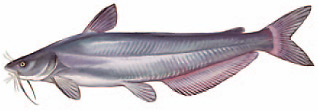 Scientific Name
Scientific Name
Ictalurus furcatus
Other Common Names
forked-tailed cat, humpback blue, chucklehead
Identification
Heavy-bodied with a wide head and high spot forward of center near the head called the dorsal hump. Upper jaw projects well beyond the lower. Bluish-gray body above, fading to white on sides and belly. No spots and a deeply forked tail. Smaller blue cats are often confused with channel catfish. Blue cats are often confused with channel catfish. Small channel cats typically will have spots lacking in small blue cats. However, large channel cats and medium-sized blue cats can be more difficult to tell apart, often having similar coloration and general body shape. The margin, or edge, of the anal fin can be used to identify these fish; blue cats have an anal fin with a very straight margin, in channel cats the anal fin has a rounded margin. Biologists and anglers can definitively distinguish between the two species by counting anal fin rays;30-35 rays in the blue cat’s anal fin verses the channel cat’s 25 to 29 rays.
Best Fishing
Rivers: James, Mattaponi, Pamunkey, Rappahannock, Staunton and Appomattox. Lakes: Buggs Island.
Fishing Techniques
March through May are the best months, but they are caught year round. Use heavy tackle with cut bait, live herring, shad, or peeler crabs. Best at night or low-light conditions.
Feeding Habits
Omnivorous, but feeds naturally on fish, crayfish, and mollusks, and scavenges on dead or dying aquatic and terrestrial animal matter. Sense of taste and smell are more important than sight in obtaining food, and whiskers are used for this purpose.
Habitat
Stocked in the Rappahannock, James, and Mattaponi rivers, as well as a few lakes. These fish are now also found in the Appomattox, Painatank/Dragon Run, and Potomac rivers. They are highly abundant in all of the tidal rivers in which they are found and occupy most habitats which occur in the freshwater, or slightly brackish, sections of these rivers.
Spawning Habits
They spawn in late spring and early summer, when water temperatures reach 70° to 75°F. Eggs are laid in masses in nests formed under logs or other submerged structure, or along undercut river banks. Young school-up after hatching.


